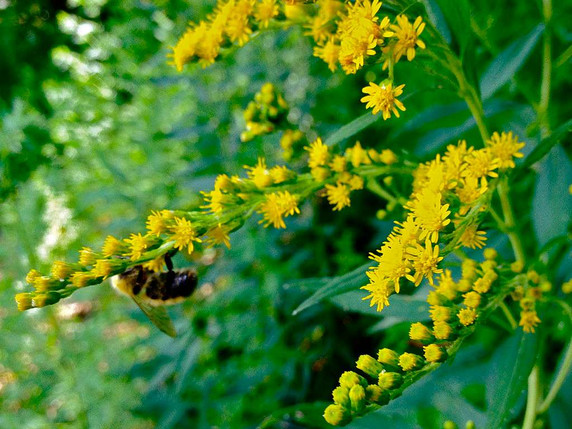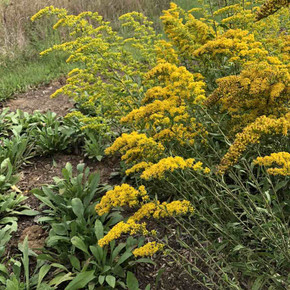
Solidago juncea - EARLY GOLDENROD (the earliest to bloom)
As the common name suggest, this is really one of the earliest Goldenrods to bloom. Excellent source of food for native bees, honeybees, butterflies and small birds.
Usually 3' tall x 2' wide (in optimum conditions can reach 4' and spread by rhizomes to 3' wide clumps). Flowers in July and August.
Full sun is the best, but tolerates half shade too. Tough and adaptable to soil conditions - from dry, shallow, rocky, gritty, leaner soils to clay or loam, or any other soil. Medium, medium-dry to dry soils. Tolerates moist soil, if it's drained well.
Native to the whole eastern half of USA and Canada, see the BONAP distribution map.
Can be found on prairies (sand prairies, gravel prairies), thickets, oak savannas, thickets, drier woodland edges, upland woods, abandoned fields, along roads.
Hardy in zones 3 - 7.
Host plant for larvae of several moths, lace bugs, leafhoppers, seed beetles, leaf beetles and others. The Greater Prairie Chicken may feed on the foliage, small songbirds feed on seeds (Eastern Goldfinch, Tree Sparrow, and Swamp Sparrow).
Mammals (including deer) can feed on the leaves.
Usually disease free and trouble free plant (some mildew or rust many appear towards the end of the season).
Best in naturalistic planting, naturalistic flower beds, prairie planting, pollinator gardens, butterfly gardens or bird gardens. Combine with other wildflowers or nativars for sun on average to dry soils.
Pot size : square 3.5" x 5" deep pot
Picture copyright : Fritzflohrreynolds, Commons Wikipedia

Solidago juncea - EARLY GOLDENROD (the earliest to bloom)
As the common name suggest, this is really one of the earliest Goldenrods to bloom. Excellent source of food for native bees, honeybees, butterflies and small birds.
Usually 3' tall x 2' wide (in optimum conditions can reach 4' and spread by rhizomes to 3' wide clumps). Flowers in July and August.
Full sun is the best, but tolerates half shade too. Tough and adaptable to soil conditions - from dry, shallow, rocky, gritty, leaner soils to clay or loam, or any other soil. Medium, medium-dry to dry soils. Tolerates moist soil, if it's drained well.
Native to the whole eastern half of USA and Canada, see the BONAP distribution map.
Can be found on prairies (sand prairies, gravel prairies), thickets, oak savannas, thickets, drier woodland edges, upland woods, abandoned fields, along roads.
Hardy in zones 3 - 7.
Host plant for larvae of several moths, lace bugs, leafhoppers, seed beetles, leaf beetles and others. The Greater Prairie Chicken may feed on the foliage, small songbirds feed on seeds (Eastern Goldfinch, Tree Sparrow, and Swamp Sparrow).
Mammals (including deer) can feed on the leaves.
Usually disease free and trouble free plant (some mildew or rust many appear towards the end of the season).
Best in naturalistic planting, naturalistic flower beds, prairie planting, pollinator gardens, butterfly gardens or bird gardens. Combine with other wildflowers or nativars for sun on average to dry soils.
Pot size : square 3.5" x 5" deep pot
Picture copyright : Fritzflohrreynolds, Commons Wikipedia









